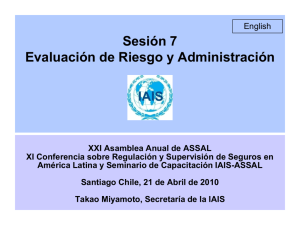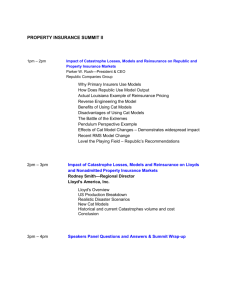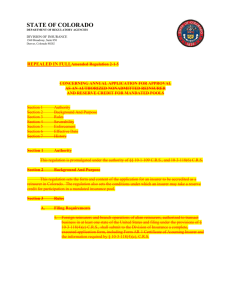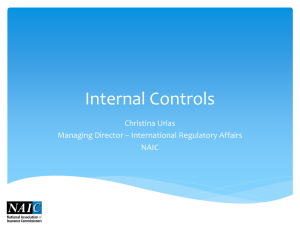Post-loss budget support
advertisement
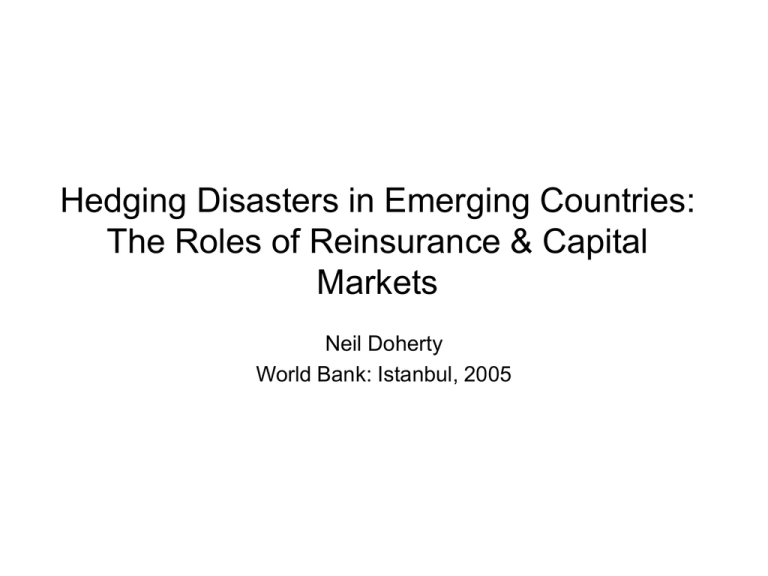
Hedging Disasters in Emerging Countries:
The Roles of Reinsurance & Capital
Markets
Neil Doherty
World Bank: Istanbul, 2005
Paying for Natural Catastrophes
• Post Loss Aid
• Post Loss Emergency and Reconstruction Loans
• Forgiveness of Existing Debt
– With enhanced debt capacity to fund reconstruction
• Internal Insurance
– Private Internal Market
– State Provided, State Reinsured/Guaranteed
• External Insurance and Reinsurance
• Country Risk Retention Groups (Pools) e.g. Caribbean
• Capital Market Instruments
Potential Roles for External Reinsurance
and Financial Markets
• Provide capital or capacity for domestic insurance risk
– Insure (reinsure) sovereign assets
– Reinsure state as domestic insurer of last resort
– Reinsure private domestic insurers
• Provide post-loss budget support for government
– Cat bonds have been issued directly for country risk; e.g. Taiwan
– Government subject to Samaritan’s dilemma
• Note enormous Samaritan’s dilemma in US after 9/11 (Victims
Compensation Fund) and Katrina (commitment to $200 billion relief &
crowding out of other government programs)
– Need for parametric (objective) trigger
• Provide post-loss debt repayment for government
– Addresses Samaritan’s dilemma. Government needs to secure new
funding (with monitoring) for post-loss relief and recovery programs
– Need for parametric (objective) trigger (?)
Layering of Catastrophe Hedge programs:
Excess of Loss Reinsurance and ILS as Options
Basic Option Framework
Reinsurance or Insurance
Linked Security (ILS)
Proceeds
π{
D
E
Loss
Prices of Reinsurance and Insurance Linked
Securities, ILS
•
•
•
•
•
•
•
Reinsurance pricing can be multiples of
2 -7 or more times E(L) (Froot 2001)
Reinsurance prices highly cyclical – high
after capital shocks (Gron-WinterDoherty/Posey)
Cat bond pricing can be multiples of up
to 5-7 times E(L) (or more) (Lane 2004)
Set up costs for Cat Bonds 2-4 times
E(L)
Set up costs may be lowered by multi
year and multi exposure structures
ILS market still small, but Reinsurance
may be CONTESTIBLE market
Broadening of investor base for
Reinsurance and ILS
Price as
multiple of
E(L)
hard
soft
Attachment point
REINSURANCE PRICING OVER CYCLE
AND ATTACHMENT (FROOT 2001)
Why are Reinsurance & ILS so Expensive?
• Cost of Capital
–
–
–
–
(a). How much risk capital is needed to write the instrument?
(b). What is the degree of diversification of risk bearer?
(c). What is the risk premium given (a) and (b)
(d). What inefficiencies are inherent in structure
• Illiquid secondary market
• Investment constraints; etc
• Set up costs including fees
–
–
–
–
Modeling
Broker, Investment Banker, etc
Regulatory/tax
SPV
• Both problems exacerbated by Single Risk (or nearly so) structures
– Failure to avail itself of diversification. Note risk and systematic risk may
both be priced. Cost of risk may be reduced if primary risk bearer
secures reinurance.
– Replication of costs.
Froot’s 8 Market Imperfections
•
•
Supply Factors
1. Insufficient Capital in Reinsurance
– Capital shortage (& prices) is cyclical
•
2. Reinsurer Market Power
– Consolidation - but new entry when market hard
•
3. Structural – corporate form inefficient
– Agency costs within structure (e.g., asset substitution in reinsurer)
•
4. Frictional costs are high
– Brokerage, etc costs; illiquid secondary market for bonds; poor risk management
•
5. Moral Hazard & Adverse Selection
– Can be mitigated by contract design – e.g. parameterized trigger
•
6. Ex Post substitutes for Insurance
– Samaritan’s dilemma ex post aid undermines future insurance
•
•
•
Demand Factors
7. Agency Costs distort Managers’ Decisions
8. Behavioral Factors Dampen Demand
Illustrating the Cost of CapitalA Layer of Reinsurance
T ( S P X )(1 r ) ( L)
Now suppose the we need to hold “k” dollars of equity to support each dollar
of premium “P”. We can rewrite this as
X (1 r ) E ( L)
P
(1 r ) k ( ROE r )
Where P is premium, X is set up cost, r is return on insurer’s investment, E(L) is
expected loss, and ROE is the investor’s required return on equity.
As a simple illustration, with:
E(L) = 100;
r = 5%
ROE = 14%
X = 100
k = 4 (This layer)
100(1 0.05) 100
P
304
(1 0.05) 4(014
. 0.05)
Note that this does NOT include costs of double taxation on capital,
Harrington and Niehaus have shown that these costs alone can be
greater than the expected loss and will be higher for higher layers
Capital multiples will be lower (higher) for lower (higher) layers
Illustrating the Cost of Capital- Reinsurance
Where P is premium, X is set up cost, r is return on insurer’s investment,
E(L) is expected loss, and ROE is the investor’s required return on equity.
As a simple illustration, with:
E(L) = 100;
r = 5%
ROE = 14%
X = 100
k=4
100(1 0.05) 100
P
304
(1 0.05) 4(014
. 0.05)
Which is 3 times the expected loss. Rates on line for high
attachments are often higher. Froot, 2001 shows reinsurance prices
multiples of 7 or higher during 1990’s which are higher at higher
attachments. Multiples have declined & are cyclical.
Illustrating the Cost of Capital- Cat Bond
(1 R) P P(1 rF ) E ( L) X cP
OR
R rF E () E ( x) c
Where P is principal, l and x are losses and set up cost (as ratio of
principal), rF is risk free rate, and c is the opportunity cost of the
activity
As a simple illustration, with:
E (l) = 0.78%;
x = 2.25%
c=1%
R rF 0.78% 2.25% 1% 4.03%
Which is over 5 times the expected loss
Lane shows multiples on EQ bonds in 5 – 7 range
Risk
Modeler
Capital Market
SPV
Postloss
budget
support
State or
Private
Insurer
Country
World Bank as
Facilitator
Single Entity Structures
ILS written on UNDIVERSIFIED risk
Reinsurer
Replication of costs: Single country ILS structures
Investors
diversification
SPV
SPV
SPV
SPV
SPV
Replication of Transaction Costs
country
country
country
country
country
Designing a More Efficient Structure
•
•
•
•
•
•
Most Efficient Deployment of Pre - and Post Loss Funds
Maximize Diversification of Loss
Maximize Efficiency in Deployment of Capital
Minimize Replication of Investment Banking, Brokerage, etc. Costs
Minimize Modeling costs (or maximize use of information)
Minimize Moral Hazard and Adverse Selection
In short
• Exploit Comparative Advantage in Risk Bearing and Technical
Capability
Comparative Advantage in Risk Bearing
•
Investors (through securitizations)
–
–
–
–
–
•
Reinsurers
–
–
–
–
–
•
Investors can take Pure Play in Cat Risk
Diversification of Cat Risk in investor portfolio
Secondary Market Illiquid
High Fees & costly external modeling
Fully collateralized – but requires enormous capital invested at low risk
Diversification across insurance and investment risk
Credit risk
Agency problems depending on corporate structure
Often has internal modeling capability
Usually requires considerable capital especially for high attachments
World Bank
–
–
–
–
–
–
Preferred creditor status (though INCREMENTAL cost of risk is relevant)
Diversified loan portfolio with world wide spread of cat risk
Bank already implicitly at risk (e.g. default and soft post disaster loans)
Can link to development loans to optimize mitigation
Can consult on, and fund, reconstruction – minimize post loss misallocation
Technical capability to embed risk management in economic development
strategy
World Bank Pool as Intermediate Risk Bearer
Suggested structure
• World Bank capitalizes an Insurance Facility - writes contracts to
– Forgive existing Bank debt triggered (parametrically) by catastrophes
– Reinsure government obligation as reinsurer of domestic cat risk
– Provide parametric hedge for reconstruction of destroyed sovereign
assets
• Facility hedges its PORTFOLIO risk with Reinsurance and/or Cat
Bonds
• This Structure
– Creates further layer of pooling BEFORE putting cat risk to market. Note
earlier WB initiatives such as Caribbean Pool.
– Enables Bank to use its own capital insofar as its incremental cost of
capital is lower than that of reinsurers (Bank can choose how much risk
to reinsure or securitize and how much to retain)
– Avoid replication of costly SPV on a country by country basis
– Enables Bank to provide integrated risk management and development
consulting and funding
– Capital saving; e.g. ILS would fully collateralize pool risk rather than fully
collateralize each country risk
Investors
Reinsurance
or SPV
World Bank
Bank Insurer
diversification
country
country
country
country
country
Capital Market
Instrument
Risk
Modeler
Reinsurer
Existing
Development
Loans
World Bank
capitalizes
Insurer
Insurer writes parametric
contracts to forgive World
Bank Debt
Forgiveness
existing
loans
Post-loss
loans etc
Pre-loss
Develop
ment
programs
Postloss
budget
support
Country 1
Pre-loss
Develop
ment
programs
Postloss
budget
support
Country 2
Pre-loss
Develop
ment
programs
Postloss
budget
support
Country “n”
World Bank SPV as INSURER of DEBT FORGIVENESS
Capital Market
Instrument
World Bank
capitalizes
Insurer
Government
Insurer
Risk
Modeler
Reinsurer
No Risk Insurer writes
parametric Reinsurance
contracts
Government
Insurer
Government
Insurer
Discussion Issues
•
•
Avoids replication of brokerage/investment banking/ etc fees
Possible saving in and/or more effective use of, risk modeling
– Would each country have to be modeled? or
– Could Bank insurer portfolio risk be modeled directly?
•
•
Is INCREMENTAL cost of risk capital greater for World Bank or for
Reinsurers and ILS investors?
Ex ante Moral Hazard. Will World Bank Reinsurer be as effective in
promoting mitigation as private insurance market? Depends on
– Whether premiums are risk related
– Depends whether World Bank can integrate insurance with effective ex ante
mitigation in its normal loan programs. Clear incentive for Bank to do this
•
Ex post moral hazard. Can be minimized with effective monitoring post-loss
recovery programs.
– Debt forgiveness contracts with new reconstruction loans
•
•
•
Can World Bank entity be a risk taker?
Can World Bank insurance entity charge risk related premiums?
Can we envision insurer capitalized jointly by World Bank and regional
development banks?


